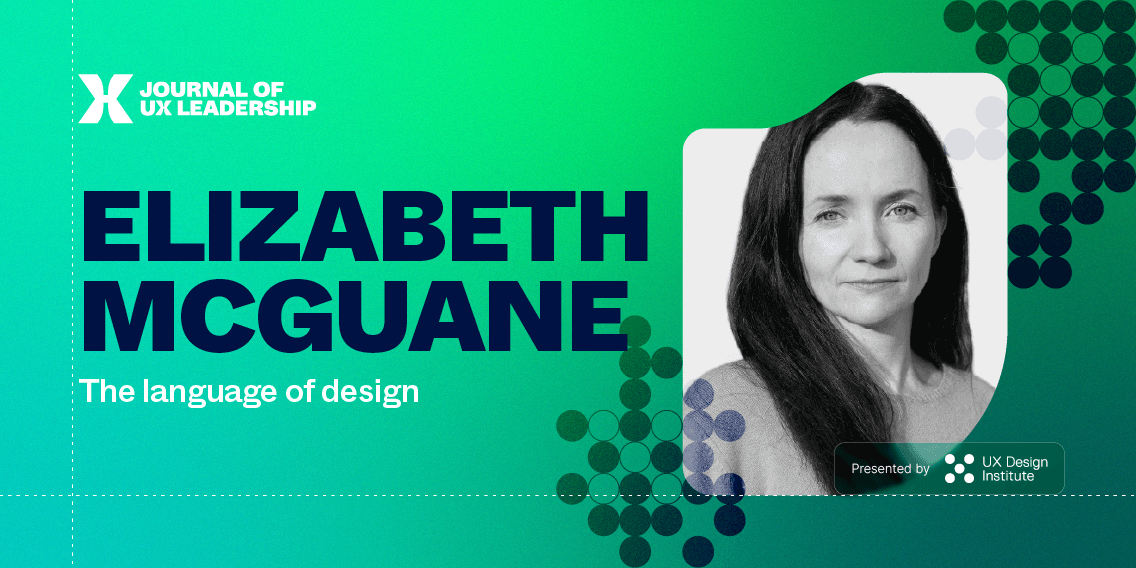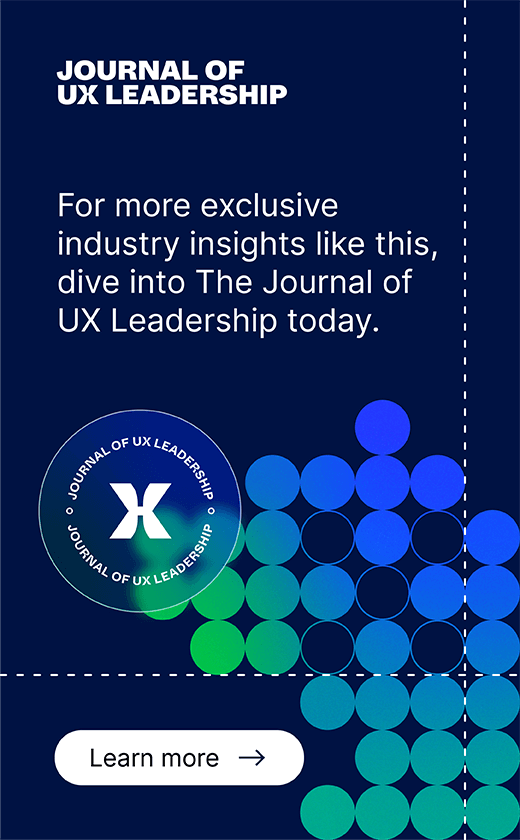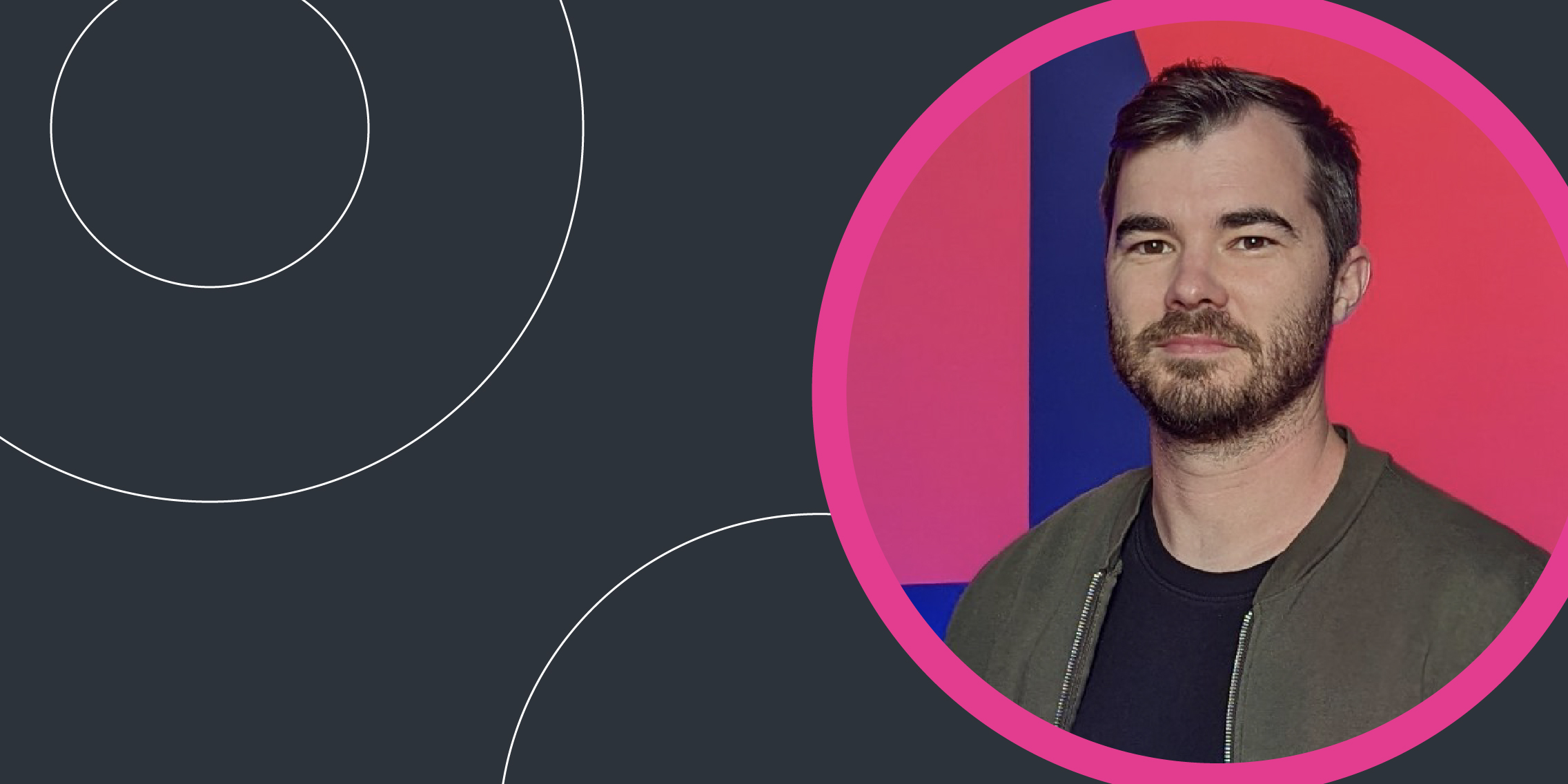Elizabeth has been working in UX for fifteen years, having made the switch from journalism. For the past three years, Elizabeth has led UX teams at Shopify and before that, she was Intercom’s first-ever content designer. In our interview, Elizabeth discusses how she has married her love of words with interaction design to lead an ambitious UX programme.
Career highlights:
- Shopify, UX Director, 2018 – present
- Intercom, Content Design Lead, 2015 – 2018
Interview themes at a glance:
- Moving from feature writing to web writing
- The breadth of different content roles
- Why content and engineering are natural allies
- When delight is not always the best user outcome
- How to keep a large UX team engaged
Gareth Dunlop: Tell me about your career in your own words. It appears to me that what started off as love of words morphed into how content influences product design and digital design?
Elizabeth McGuane: I often wonder what my career must look like from the outside because from the inside it has felt very organic and I would never have planned to be where I am. It was a strange privilege to start out in UX when I did – around 2007 – in a Dublin-based UX agency called IQ Content.
Around 2000, just after the first dot com boom, the web was really kicking off. I was working at a newspaper in Dublin, The Sunday Business Post as an editorial assistant, I was literally the runner. The newsroom was virtually unchanged from how it was in the 80s and the 90s. So naturally I became the web go-to person, finding things on the internet, interested in how the web was changing our industry and reading a lot of things about early UX.
I wrote a letter to IQ Content, literally because they had the word “content” in their name and they worked in the digital space! Luckily enough that letter landed with the person who became my early mentor, John Wood. Eventually they hired me, working on websites for the Irish government, insurance companies and other large corporations. These organizations were large and complex and produced mountains of content, so we spent most of our days wading through the information to find what was relevant to users and their goals.
GD: Were the success factors of what makes a good feature article very different to those which underpin a helpful piece of web content?
E McG: In a newsroom, content was drafted, went through sub-editors and editors, was often restructured and eventually published. A good design process similarly evolves through iterations until it’s ready to be put in front of users. How these things fit together on a physical thing or a website or a web app is much more three-dimensional. How is someone navigating through it? How are these things co-located together? Which pages are we grouping together? Can people find them?
GD: As you moved into web publishing, how did you balance the creative element of writing with some of the more analytical considerations which web writing involves?
E McG: The key learning was moving away from a focus on “pages” which was how we thought in publishing – on the web the words express themselves interactively as building blocks – some will become buttons, links and other navigational items. So, I started to see writing less about producing prose and more about sewing together a patchwork quilt.
I also became less attached to the tone of voice and more interested in simplicity and utility. In the end I felt more like an architect than a prose-writer, putting LEGO blocks together in the most useful way possible for users.
The breadth of different content roles
GD: Over the years when I have worked with content professionals, I’ve observed that for some the analytical considerations come very naturally to them and for others it has been a challenge. Some feel that the data element gives their writing purpose, yet others feel it constrains their creativity. Have you experienced that dynamic?
E McG: UX writing, content strategy, content design copywriting – all of these jobs are different, so it’s really important that we don’t just put everyone in one bucket. I’ve always thought about it as a spectrum, where you have system-oriented people at one end and editorially-oriented people at the other.
Often when I’m working on a brand-led experience, such as a brand website, there is a mix of skills required that no one person can reasonably be expected to have. For example, sometimes I’ve needed somebody who has a really strong sense of voice and a really strong sense of style, and those are very different skills to assessing how SEO should influence content.
Copywriting is still so important – people can dismiss it “oh I’m doing something much more important, much more architectural” but it’s still the skill which underpins all of our content efforts. I remember back in 2009 going to the first content strategy forum in Europe, which was in Paris. Typically for early UX, and probably current UX, everyone was obsessing about what they should call themselves – the consensus at the time was that content people should fly under the banner of “content strategist” because collectively they would have more impact that way. I think there was truth to that in that moment, but the industry has matured and evolved significantly since then.
GD: So as the worlds of content design and interaction design converged for you, did that put you in good standing as you moved to other roles?
EMcG: This brought me back to my LEGO bricks and patchwork quilts – I was no longer producing content, rather I was producing content types. I spent a lot of time thinking about content and format and locales, along with content strategy and architecture. It was very interesting because we were just learning about how users behave on interactive media, mobile apps were just starting to become popular and early-stage chat-based tools were emerging. It was a wonderful time where I had a chance to work on early-stage technologies in an environment where we needed to innovate every day because no one had yet written the rules.
Around that time some former colleagues who had set up Intercom got in touch to tell me they were setting up a content design discipline within the business and asked me to start it. The opportunity was appealing because it was so broad – they wanted content to influence their marketing language, product names and product design but also new areas for me like their software code and associated naming and structure standards.
UX writing, content strategy, content design copywriting – all of these jobs are different, so it’s important we don’t put everyone in one bucket.
The engineering element was a real novelty because I think a lot of people perceive a tension between content people and engineering people, but my experience is that there is no tension because those are the two teams that care the most about the finer details – literally about how it’s built and what it says. One of our aspirations was that the code base would use the same naming conventions as the UI. It’s a lofty ambition because it is so difficult to maintain that purity of language as a digital product evolves. Digital products are meant to evolve and so we loosened our grip on uniformity for its own sake.
I focused a lot on Intercom’s Messenger which in time evolved into their first chatbot and in those early days I worked closely with some great designers there and our complementary skills really allowed us to do great things. At different times in my career, I’ve had that partnership with one designer or art director, where for both parties we achieve more than the sum of our parts.
The beauty of the chatbot for me was that the words are literally the design. I believe that we should view words as patterns, that those patterns should be very carefully designed and that they shouldn’t be replaced with other words willy-nilly because they had a very specific outcome in mind, whether it was trying to get someone to give you their email so that you could follow up with them or whether it was trying to get an answer for them through an automated machine learning driven help. Looking back, I think we were doing the deepest type of product design possible because we were thinking about a very, very specific tool doing a very, very specific thing.
GD: Do you have any examples you can share about some of the naming and labeling decisions you were making around that time?
E McG: We spent a lot of time thinking about the chatbot’s name. The name is important because when you consider Alexa or Siri it is literally the handle you use to open the tool. We discovered that in text, because there is other material to engage the tool, the name does not have that same power. In a chatbot it goes beyond that because the person is not trying to talk to a bot, they’re trying to get an answer. So we found that anything that overtly expresses too much personality gets in the way of that experience that they’re trying to have.
We had a hypothesis that the name might provide an opportunity for expression and delight but the research invalidated it pretty quickly! It was like you going up to an information desk when you’re really stressed out and trying to find something in a department store and the person behind the desk giving you a big song and dance of brand advertising before they answer your question.
We’re seeing this at the minute with ChatGPT. Currently, we are all playing with it but as it evolves its practical and pragmatic application will increasingly mean users don’t even consciously consider that it is AI. The hype cycle often starts with a fascination for the technology but that recedes and is replaced with a task-focused pragmatism.
Delight is not always the best user outcome
GD: I think sometimes there’s a temptation to think that a positive outcome is delight. But sometimes we don’t want delight, we just want our broadband to work again, or to know when our package will be delivered. In those situations speed and confidence are far more appropriate targets than delight?
EMcG: And satisfaction. The goal is the user’s delight or satisfaction, not the tool being delightful. And I think that’s a really hard thing for people to get because brands and companies want to push a certain brand message, so they end up obsessing about what they’re pushing out instead of focusing on what the user is getting on the other side.
This is connected to another key component of good outcomes – user expectation. When users are engaging with a tool, whether it’s in a messenger or sending an email, they have an uncanny ability to perceive if the response is from a human or a robot. AI is definitely getting us closer and closer to seeming human, but I think we should wait and see what happens, because it only takes one misstep for a user’s spidey sense to hone in and go, oh wait, this isn’t human.
I had been thinking for over a decade about the principles of visual design. I just hadn’t got round to calling it design!
GD: At this stage of your career, you’ve spanned the bridge between content and interface design, but also content in a product business which impacts everything from marketing to branding to chat?
EMcG: I spoke to a colleague at Shopify who also came from a content strategy background and had transitioned to broader design leadership and she encouraged me to think strongly about doing the same thing.
When I reflected on my experience, I had been thinking for over a decade about the principles of visual design – proximity, grouping, hierarchy and other information design building blocks. I just hadn’t got round to calling it design!
I took a role as a UX manager looking after a team of four working on the core platform. We were responsible for the app store, whose users comprised mainly developers and partners (who offer ancillary services such as photography).
My team grew to 12 to 18 people and we put a modest management structure in place with 2 managers reporting to me. I hadn’t pursued that manager track but when it came to me I embraced it because of all the things I loved to do as a content designer I loved to do as a manager – close collaboration, merging different skills together, critiquing and breaking apart a problem as part of a team. As things progressed, I then moved to a senior manager role and today I am a director with a team of 32, and a big part of our focus brings me back full circle to the building blocks of content – information architecture and navigation design, both menu-led and search-led.
GD: How do you think the difference between product-led and engineering-led cultures manifests itself day to day?
EMcG: The cultural and intellectual background and interest of the founders, especially in very founder-led companies like both Intercom and Shopify, are what shapes culture. But it’s not purely binary – for instance at Shopify it’s not the case that everybody only cares about engineering and design gets short shrift. I think it plays out mostly in terms of what the company invests in and what it understands its primary problems to be. For instance, Shopify is rightly always interested in its tech stack – so the decision-making process is to say we’ll migrate to a technology and improve our UX as we go.
GD: Within a competitive marketplace and an ambitious product roadmap do you find space for ideation and innovation and managed risk?
EMcG: Shopify has kept its desire to hang on to that early startup, hacky way of approaching problems and getting things done quickly. We still do hack weeks several times a year and products emerge from those – for example our checkout emerged from a hack day.
How to keep a large UX team engaged
GD: What are the challenges you face in keeping a team of 32 people motivated, focused and well-skilled?
EMcG: We’ve had space to work on short-term high-impact projects which have really improved the front-end, just prioritizing things that no one has ever got round to doing such as upgrading our rich text editor. These small pieces of work are pure design projects – they don’t impact systems teams or infrastructure teams – so we’ve been able to just crack on. I think we’ve become more attractive internally around the company because we’ve been successful with those smaller initiatives.
There are challenges too of course – in my first few years at Shopify we were at the massive curve of its success and of course e-commerce thrived during the pandemic. Since then the whole tech industry has been less stable and people are less tempted to look elsewhere. I make sure I don’t rest on my laurels as I want people to feel empowered to feel like this is a very positive place to do good design work. I truly believe that people stay at companies because of their manager, not because of the company.
GD: On the subject of human connection, what is the ideal combination of soft skills and hard skills you encourage in your team?
EMcG: We have a saying at Shopify “do things, tell people” but often the better the designer the less willing they are to tell people what they are doing. They do great things all the time but are shy about telling others. I reinforce to my team the importance of the storytelling element, sharing the insights around – there is no point doing amazing design and research if only one team ever knows about it.
One of the interesting things for me in the past four years has been leading people at different stages of maturity in their career – there is a chasm between leading someone who is early in their career and someone who is more experienced. People who are earlier in their career are still getting up to speed with their craft and dealing with their insecurities. In terms of how those people progress I have some control over promotion and retention, but not total control – so I work hard to build relationships not just with my team but with others across the business.
It’s the same with my designers – a good designer is comfortable working in the open. Sometimes my designers can be tempted to avoid collaboration, to go away and work on their own. And while designers need thinking time, I encourage my team to reach the stage of maturity where they are comfortable being wrong, working in the open and working collaboratively.
GD: Is reinforcing design’s return on investment to non-design colleagues part of your role?
EMcG: Yes, we usually frame that conversation in the language of quality and impact evaluation. There is a sense that as long as we are evaluating in the right way, we don’t need to pursue perfection – we just need to make sure that the product is better today than it was yesterday. Sometimes we measure speed, for instance we changed a page recently so that a function could be launched directly from search results. This reduced task completion time by six seconds – that is a metric which everyone can understand and embrace. There is a realization too that sometimes you just can’t measure a positive design contribution – sometimes good design is simply the right thing to do.
GD: We have arrived at the part of the interview where I invite you to talk about your book! Why should we all buy it and read it?
EMcG: It’s called Design by Definition and will be published by A Book Apart this summer. The genesis of the book lies in a talk I gave at the Design Leadership Summit in Toronto in 2019, after which designers approached me who weren’t content designers – they were motion designers or illustrators or graphic designers and they told me that I had accurately articulated a part of their design process that they had never articulated before – that the words you use to describe a problem will literally shape the problem, and thus the solution that you make for that problem. In other words, if you take care crafting the language used to frame a problem it will positively shape the solution.
Note: This interview was conducted for the Journal of UX Leadership, a new publication from the UX Design Institute for ambitious UX professionals who want to learn from their peers and grow their careers.





